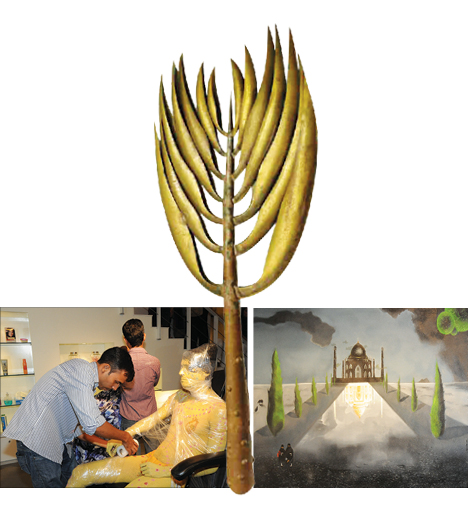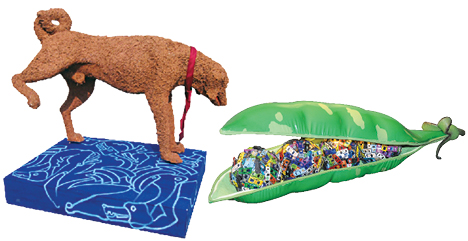'@RT VIRTUALLY REAL’, the first annual Show at ‘Art Alive Gallery’, of a new art portal for emerging artists—Emergingartists.in—assembles an unusual array of experimental art practices by 22 young Indian artists from varying regions. This synergetic collection includes works by Abir Patwardhan, Aditi Kulkarni, Anil Thambani, Debashish Datta, Gaurav Singh, Harekrishna Taulkdar, Kanika Sharma, Mahua Sen, Nakul Mondol, Nilanjana Nundy, P Bujinga Rao, Padmaja, Parag Sonarghare, Prasun Roy, Pratap Morey, Rajesh Salgaoncar, Rajnish Chhanesh, Samir Tawde, Satadru Sovan, Siddharth Pansari, Sonatina Mendes, Sudipta Das, Suraj Kumar Kashi and Vijil Chooliyad. From paintings to ‘happenings’, ‘virtual’ expressions, digital art, videos, sculpture and installations, the show puts forth a range of tangential new visual forms of expression, in an attempt to reflect today’s ethos via a melange of media.
The emerging artists, largely discovered online via the internet, which enabled them to stay in communication with each other, are exhibiting within an urban context together for the first time. A majority of these participants have recently emerged from remote small towns of India, struggling to achieve an authentic idiom of urban contemporary expression, and to ‘arrive’ as individual entities within the ‘urban dreamland’. This facet makes the show
worth observing.
For instance, Vijil and Suraj originate from very remote interior villages of Kerala and Bihar, and their arcane mythic and sociocultural roots are quite evident in the detailed canvasses that incorporate narrative storytelling disciplines with a certain quixotic ‘magic-realism’. In fact, this approach is like a skein binding most of the Show’s works. Further, a major inspiration behind these expressions is the rapidly-expanding presence and impact of the internet -- opening-up a whole new cyber-dreamworld across the country.
Cyberspace now provides contemporary images and information to those who were previously uninformed and ‘under-developed’, on the margins or peripheries of the ‘developed’ society. Within the artistic context, this proliferation of Cyber-imagery has now opened-up an entirely new imaginative world of expressive communication for aspiring artists. Via the internet, even Mofussil-town rickshaws and squalor express themselves in a valid cyber-art language via online posts and flash-formatted videos, as emblems of ‘local colour’ that can communicate internationally in
real time.
Gaming, social networking, flash art, random video clips, found footage, mall media and spontaneous online commentary-chronicles are now amorphously generating a massive new resource-archive of materials for an entirely new visual-linguistic set of devices, portending a new kind of ‘stylistic’. This Show comprises such scattered trajectories of semi-formed cyber-experiences. It must be noted, however, that these new visual modes may also hover on the brink of becoming ‘gallery-fads’, losing the clarity and skill of actual artistic accomplishment.
“Slippage and disjuncture exists between the real and the virtual; it is from within the trenches of this ravine that one begins a dialogue. Is virtual reality now more real than reality itself?” -- states the Show’s press release, curated by Georgina Maddox. However, the truth is that ‘Clarity is reality’ -- as a famous artist once said. The haze of the virtual world cannot ever ‘replace’ the clarity of the real; it can, at best, be used as a new conduit to express reality. The ultimate success of any creative work depends upon its clarity of expression. And it is within this criterion that a certain clear point is missed in this Show.

A majority of overly-amorphous works falter under a shaky umbrella of collective expression, despite a few individual works containing skill and clarity. Most of the fledgling works hover like half-utterances, initial experiments created ‘within the trenches’ – possibly by disoriented ‘art-guerillas’ trying to quickly find their way through a threatening urban minefield. In order for more cohesive Curation, a distinct Curatorial theme needed to have been applied, with the artistic renditions adhering to a clearly-articulated theme. This body of works does not generate any clear, cohesive statement.
A ‘happening’ with a ‘Retro’ feel, reminiscent of the 1960’s art scene, opened this Show. In what can be described as a ‘live installation’ at the Gallery’s lower level, a ‘performance’ was conducted in a set, recreating a barber’s shop with two chairs. The artist, Parag, was slowly wrapped-up in sheathes of plastic in the first chair, like an op-art mummification; while in the second chair, regular customers took haircuts and shaves. The intent of this ‘happening’ was, seemingly, to evoke the aspects of ‘self-re-invention,’ while trying to find a ‘skin to be comfortable in’. While the point was being stretched too far in lengths of plastic, one searched in vain for the actual aesthetic content of this piece of drama. Experimental attempts at ‘art’ are welcome in a generalised sense -- but in this attempt, the multi-layered anxieties of new entrants to the big city were not really evoked to much effect.
Among the actual artworks, the detailed paintings of Suraj Kumar Kashi from Bihar stood out, with their intricacy and delicate yet confident application of a full-spectrum palette. A charming panoply of eccentric and quixotic Indian characters people these narrative canvasses, indicating considerable artistic discipline. Anil Thambani’s slightly Surreal depiction of the Taj Mahal, with a pair of Burqa-clad visitors in a corner, evoked painterly mystery. By contrast, the graphics, prints and video installations left one with a feeling of thematic emptiness. While one was bemused by Harekrishna’s peeing dog sculpture of a street dog wearing a tie, one wondered whether it contained any aesthetic material higher than a titter of sheer amusement. Abir’s large metallic trees bear a tribal boldness of idiom, but they need greater contextual detailing.
Regardless of its semi-formulated ideas, the positive synergy of this experimental exhibit lies in the fact that its young artists stem from a widely-authentic range of Indian backgrounds -- from Baroda and the Ecole des Beaux Arts to Business Studies, Photojournalism and Feminism; from such diverse places as Benaras, Visakhapatnam, Goa, Mumbai, Delhi, Kolkata, mofussil small-towns and interior villages; with inspirations as varied as Tagore, Gandhi, Surrealism, and the current Mall-culture; and with eclectic exhibition-experiences from the Worldwide Web to New York and South Africa.

The awkward outsider, the alienated loner, and the migrant searcher have found a new forum in creative self-expression via the Web – which is actually where the curator ‘met’ the artists and communicated with them in order to put together this Show. The Web has indeed narrowed down communication-barriers and broken certain walls. Outmoded art-coteries, and the boring social club-culture have broken down now, giving way to more democratic and independent communications. Therefore, increasingly, the human dynamics of the Web, as a major aspect of sociological and creative evolution, must find clearer ways to express its nuances in Indian Contemporary Art.
Read More...